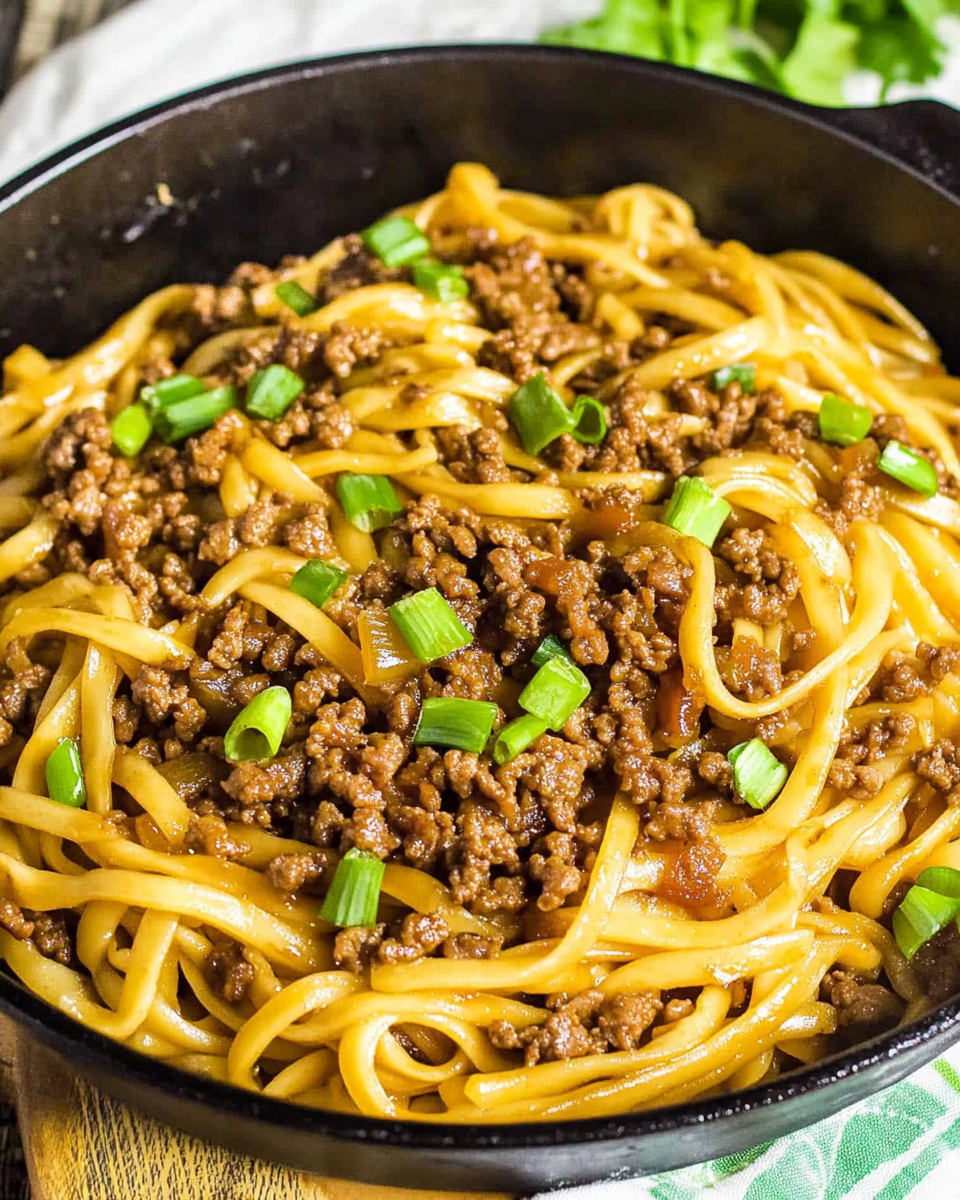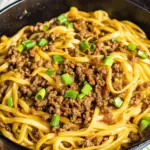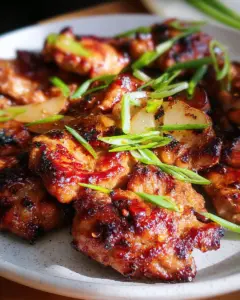If you love the bold, savory-sweet flavors of Asian takeout but want a quicker, healthier alternative, Ground Beef Mongolian Noodles are the answer. This dish combines tender linguine or fettuccine with richly seasoned ground beef, all coated in a glossy sauce made from hoisin, soy sauce, brown sugar, and aromatics. The result is a restaurant-worthy meal that’s ready in just 30 minutes—faster than delivery.

What sets this recipe apart is its customizable balance of flavors. Prefer it spicy? Add extra red pepper flakes or a drizzle of sriracha. Want more veggies? Toss in bell peppers or snap peas. The sauce clings perfectly to the noodles, ensuring every bite is packed with umami depth and a hint of caramelized sweetness. Plus, using lean ground beef keeps it hearty without excess grease.
Preparation Phase & Essential Tools
Before you start cooking, gather these key tools to streamline the process:
- Large Skillet (High-Sided): Essential for browning the beef and simmering the sauce without spills. A non-stick or cast-iron skillet works best.
- Pot and Colander: For boiling and draining the noodles. Choose a pot large enough to prevent sticking.
- Wooden Spoon or Spatula: Helps break up the ground beef into even crumbles.
- Measuring Cups/Spoons: Precision matters for the sauce’s sweet-salty balance.
- Knife and Cutting Board: Freshly minced garlic and ginger deliver brighter flavor than pre-packaged versions.
Why These Tools Matter
- A high-sided skillet prevents sauce splatters and allows room to toss the noodles.
- Undercooking the pasta slightly (al dente) ensures it won’t turn mushy when mixed with the sauce.
- A cornstarch slurry (cornstarch + water) thickens the sauce evenly without clumps.
Preparation Tips for Success
- Prep Ingredients First: Mince the garlic and ginger beforehand to avoid burning them while multitasking.
- Control Saltiness: Use low-sodium soy sauce and beef broth—the hoisin and brown sugar already add saltiness.
- Customize Sweetness: Reduce brown sugar to ¼ cup if you prefer less sweetness, or add a teaspoon of honey for complexity.
- Vegetable Add-Ins: For extra crunch, sauté matchstick carrots or broccoli florets separately and stir them in at the end.
Ingredients List
For the Beef and Sauce
- 1 pound lean ground beef (90/10 blend minimizes grease)
- 4 teaspoons fresh ginger, minced (or 1 teaspoon ground ginger in a pinch)
- 6 cloves garlic, minced (about 1½ tablespoons)
- ½ cup brown sugar (adjust to taste)
- ½ cup beef broth (or substitute with water + ½ teaspoon bouillon)
- ½ cup low-sodium soy sauce (or tamari for gluten-free)
- 4 tablespoons hoisin sauce (the secret umami booster)
- ½ teaspoon black pepper
- ½ teaspoon red pepper flakes (omit for mild versions)
For the Noodles
- 10 ounces linguine, fettuccine, or spaghetti (about ½ standard package)
To Thicken the Sauce
- 1 tablespoon cornstarch
- 2 tablespoons water
For Garnish
- 4 green onions, thinly sliced
Step-by-Step Cooking Instructions
- Cook the Ground Beef
- Heat a large skillet over medium heat. Add the ground beef and cook for 5–6 minutes, breaking it into small crumbles with a spoon.
- In the last 2 minutes, add the minced ginger and garlic. Stir constantly to prevent burning.
- Cook the Pasta
- While the beef browns, bring a pot of unsalted water to a boil.
- Add the noodles and cook for 1 minute less than the package’s al dente time. Drain and set aside.
- Make the Sauce
- Drain any excess fat from the beef (optional for lean cuts).
- Return the skillet to heat and add soy sauce, beef broth, brown sugar, hoisin, black pepper, and red pepper flakes. Stir until the sugar dissolves.
- Thicken the Sauce
- In a small bowl, mix cornstarch and water into a smooth slurry.
- Pour the slurry into the skillet, stirring continuously. Simmer for 2–3 minutes until the sauce thickens to a glossy, syrup-like consistency.
- Combine Noodles and Beef
- Add the drained noodles to the skillet. Toss with tongs until evenly coated.
- Let the noodles sit in the sauce for 2 minutes to absorb flavors.
- Garnish and Serve
- Sprinkle with sliced green onions and serve immediately.
Presentation matters when serving this vibrant dish. For an authentic Asian-inspired experience, follow these plating tips:
- Nest the noodles in shallow bowls to showcase the glossy sauce coating each strand
- Sprinkle extra green onions on top for a pop of color and fresh crunch
- Add texture contrast with a scattering of toasted sesame seeds or crushed peanuts
- Serve with chopsticks and a spoon to capture every bit of sauce
This dish shines as a standalone meal but pairs exceptionally well with traditional Asian sides. The rich, savory flavors balance beautifully with lighter accompaniments.
Common Mistakes and How to Avoid Them
Even simple recipes can go wrong without proper technique. Here are the most frequent pitfalls and professional solutions:
- Overcooked noodles
Mushy pasta ruins the texture. Always cook noodles 1 minute less than package directions since they’ll continue cooking in the sauce. Rinsing after draining stops the cooking process but removes starch needed for sauce adhesion – skip this step. - Sauce too thin or thick
Improper slurry incorporation causes texture issues. For perfect consistency:- Whisk cornstarch and water completely before adding
- Pour slurry in slowly while stirring constantly
- Simmer sauce until it coats the back of a spoon
- Bland flavor profile
Boost depth if flavors fall flat by:- Blooming garlic/ginger in oil before adding beef
- Adding 1 tsp fish sauce or oyster sauce to the mixture
- Finishing with a squeeze of lime juice to brighten flavors
- Greasy final product
Excess fat makes the dish heavy. Drain beef thoroughly after browning, or use a lean 93/7 blend. For richer flavor without grease, try ground chuck (80/20) but blot with paper towels after cooking.
8 Perfect Side Dish Pairings
Complement your Mongolian noodles with these balanced accompaniments:
Vegetable-Based Sides
- Garlic sautéed baby bok choy
Quick-cooked in sesame oil with minced garlic (2 minutes) for crisp-tender texture - Asian cucumber salad
Thinly sliced cucumbers tossed with rice vinegar, sugar, and red pepper flakes - Blistered shishito peppers
Charred in a dry skillet and finished with flaky sea salt - Pickled vegetable slaw
Shredded carrots and daikon quick-pickled in rice wine vinegar
Protein Additions
- Steamed pork dumplings
Store-bought gyoza heated through in the microwave or pan-fried - Soy-marinated soft boiled eggs
Eggs soaked overnight in a soy-mirin mixture for umami richness
Soup and Extras
- Miso soup with tofu
Light broth balances the dish’s richness - Crispy wonton strips
Store-bought or homemade for added crunch
Wine and Beverage Pairings
The sweet-spicy profile pairs well with:
- Off-dry Riesling – Cuts through richness while complementing sweetness
- Hibiscus iced tea – Tartness balances the savory notes
- Japanese barley tea – Nutty flavor cleanses the palate
- Light lager beer – Crisp carbonation contrasts the hearty dish
Meal Prep and Scaling Tips
For efficient cooking:
- Double the sauce and freeze half for future quick meals
- Prep vegetables in advance (store sliced onions/peppers for 3 days)
- Cook noodles al dente if planning leftovers – they firm up when reheated
- Portion individually for easy grab-and-go lunches
When scaling up:
- Use a wok or extra-large skillet to prevent overcrowding
- Brown beef in batches to ensure proper caramelization
- Increase sauce simmer time by 1-2 minutes when doubling quantities
Dietary Adaptations
Make this dish work for various needs:
- Gluten-free: Use tamari instead of soy sauce and rice noodles
- Low-carb: Substitute zucchini noodles or shirataki noodles
- Vegetarian: Swap beef for crumbled extra-firm tofu or mushrooms
- Dairy-free: Naturally contains no dairy (check hoisin labels)
Troubleshooting Texture Issues
If your dish doesn’t turn out as expected:
- Sauce too thick? Stir in warm broth 1 tablespoon at a time
- Noodles sticking together? Toss with 1 tsp sesame oil after draining
- Beef crumbles too large? Break up with a potato masher while cooking
- Not saucy enough? Increase broth to 3/4 cup and cornstarch to 1.5 tbsp
To maintain optimal texture and flavor when storing leftovers:
Refrigeration
- Cool completely before storing (within 2 hours of cooking)
- Place in an airtight container with a tight-fitting lid
- Separate noodles and sauce if possible for best texture
- Consume within 3 days for peak quality
Freezing Considerations
- Freeze sauce and beef mixture alone for up to 1 month
- Noodles become mushy when frozen – cook fresh when ready to serve
- Portion into freezer bags, removing excess air
- Thaw overnight in refrigerator before reheating
Reheating Techniques
- Stovetop Method (Recommended):
- Warm in a skillet over medium-low heat
- Add 1-2 tablespoons of beef broth or water to refresh sauce
- Stir frequently until heated through (about 5 minutes)
- Microwave Method:
- Place in a microwave-safe dish
- Cover with a damp paper towel to retain moisture
- Heat in 30-second intervals, stirring between each
Reviving Leftovers
- Refresh flavors with a splash of soy sauce or rice vinegar
- Add fresh garnishes like green onions or cilantro
- For extra texture, top with fresh bean sprouts or crushed peanuts
Frequently Asked Questions
Can I make this dish ahead of time?
Yes, with proper preparation:
- Cook components separately
- Store noodles and sauce in different containers
- Combine when ready to serve
- Sauce actually develops more flavor when made 1 day ahead
What’s the best noodle substitute?
Excellent alternatives include:
- Udon noodles for chewiness
- Soba noodles for nutty flavor
- Rice noodles for gluten-free option
- Zucchini noodles for low-carb version
How can I reduce the sodium content?
Try these adjustments:
- Use low-sodium soy sauce and broth
- Reduce hoisin sauce by half
- Increase fresh ginger and garlic for flavor
- Add a squeeze of citrus at the end
Why is my sauce too sweet?
Balance it by:
- Adding 1 tablespoon rice vinegar or lime juice
- Increasing soy sauce by 1-2 teaspoons
- Incorporating ½ teaspoon fish sauce for umami
- Garnishing with fresh chili slices
Can I use other proteins?
Excellent protein substitutions:
- Ground chicken or turkey (adjust cooking time)
- Thinly sliced flank steak (sear first)
- Shrimp (add at the end)
- Tofu (extra-firm, pressed and cubed)
Expert Tips for Recipe Perfection
Flavor Enhancement
- Toast whole spices (star anise, Szechuan peppercorns) in oil first, then remove
- Finish with a drizzle of chili oil for complexity
- Add 1 teaspoon sesame oil at the end for aroma
Texture Improvements
- Blanch vegetables separately for crisp-tender results
- Toast noodles lightly in oil before boiling for nuttiness
- Reserve pasta water to adjust sauce consistency
Time-Saving Hacks
- Use pre-minced ginger and garlic (1 tsp = 1 clove garlic)
- Pre-mix dry ingredients (sugar, spices) in advance
- Batch cook beef and freeze in recipe-sized portions
Nutritional Considerations
For healthier modifications:
- Reduce sugar by half and add grated apple for natural sweetness
- Increase vegetables to 2 cups (bell peppers, mushrooms)
- Use whole wheat noodles for added fiber
- Substitute coconut aminos for soy sauce
Allergen Information
- Contains: Wheat (noodles, soy sauce), Soy
- Potential allergens: Sesame (hoisin sauce)
- Gluten-free option: Use tamari and rice noodles
Final Thoughts
This Ground Beef Mongolian Noodles recipe delivers restaurant-quality flavors with weeknight convenience. The perfect balance of sweet, savory, and spicy elements makes it endlessly adaptable to personal tastes. Whether you’re meal prepping for busy days or serving a family dinner, this dish satisfies with its rich sauce, tender noodles, and flavorful protein.
Key takeaways for success:
- Control sauce consistency with proper cornstarch slurry technique
- Customize ingredients to suit dietary needs and preferences
- Store components separately for best leftover quality
- Experiment with garnishes to keep the dish exciting
For those who enjoyed this recipe, consider exploring other Asian-inspired noodle dishes like Pad Thai or Dan Dan Noodles. The techniques learned here – proper sauce thickening, balancing flavors, and efficient prep – apply to countless other culinary creations.
Ground Beef Mongolian Noodles
Ingredients
For the Beef and Sauce:
- 1 pound lean ground beef
- 4 teaspoons fresh ginger minced
- 6 cloves garlic minced
- ½ cup brown sugar reduce to ⅓ or ¼ cup for less sweetness
- ½ cup beef broth
- ½ cup low-sodium soy sauce
- 4 tablespoons hoisin sauce low-sodium, if available
- ½ teaspoon black pepper
- ½ teaspoon red pepper flakes optional
For the Noodles:
- 10 ounces noodles linguine, fettuccine, or spaghetti
- To Thicken the Sauce:
- 1 tablespoon cornstarch
- 2 tablespoons water
For Garnish:
- 4 medium green onions sliced
Instructions
- Cook the Ground Beef
- In a large skillet with high sides, brown the ground beef over medium heat.
- Add the minced ginger and garlic during the last 2 minutes of browning. Break up the beef into small crumbles as it cooks.
- Cook the Pasta
- While the ground beef is cooking, cook the pasta according to package instructions.
- Note: Do not salt the pasta water, as the sauce is already salty.
- Drain the pasta and set aside.
- Make the Sauce
- Drain any excess fat from the cooked ground beef and return it to the skillet.
- Add the soy sauce, beef broth, brown sugar, hoisin sauce, black pepper, and red pepper flakes (if using). Stir to combine.
- Thicken the Sauce
- In a small bowl, dissolve the cornstarch in the water to create a slurry.
- Add the slurry to the skillet and stir.
- Bring the mixture to a low boil and cook until the sauce thickens slightly.
- Combine the Noodles and Sauce
- Add the cooked and drained noodles to the beef mixture. Stir to combine, ensuring the noodles are well coated with the sauce.
- Let the noodles sit in the sauce for a few minutes to absorb the flavors.
- Serve
- Garnish with sliced green onions and serve hot. Enjoy this sweet and savory noodle dish!
- Notes
- Customize Sweetness: Adjust the amount of brown sugar to suit your taste preference.
- Add Vegetables: Feel free to add veggies like broccoli, snap peas, or carrots for a heartier dish. Cook them separately or sauté them with the beef.
- Spice Level: Add more red pepper flakes or sriracha for a spicier kick.
- Storage: Store leftovers in an airtight container in the refrigerator for up to 3 days. Reheat in a skillet or microwave.






